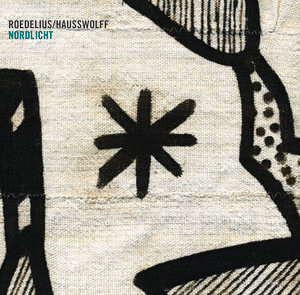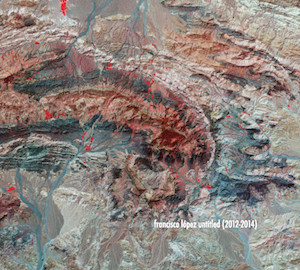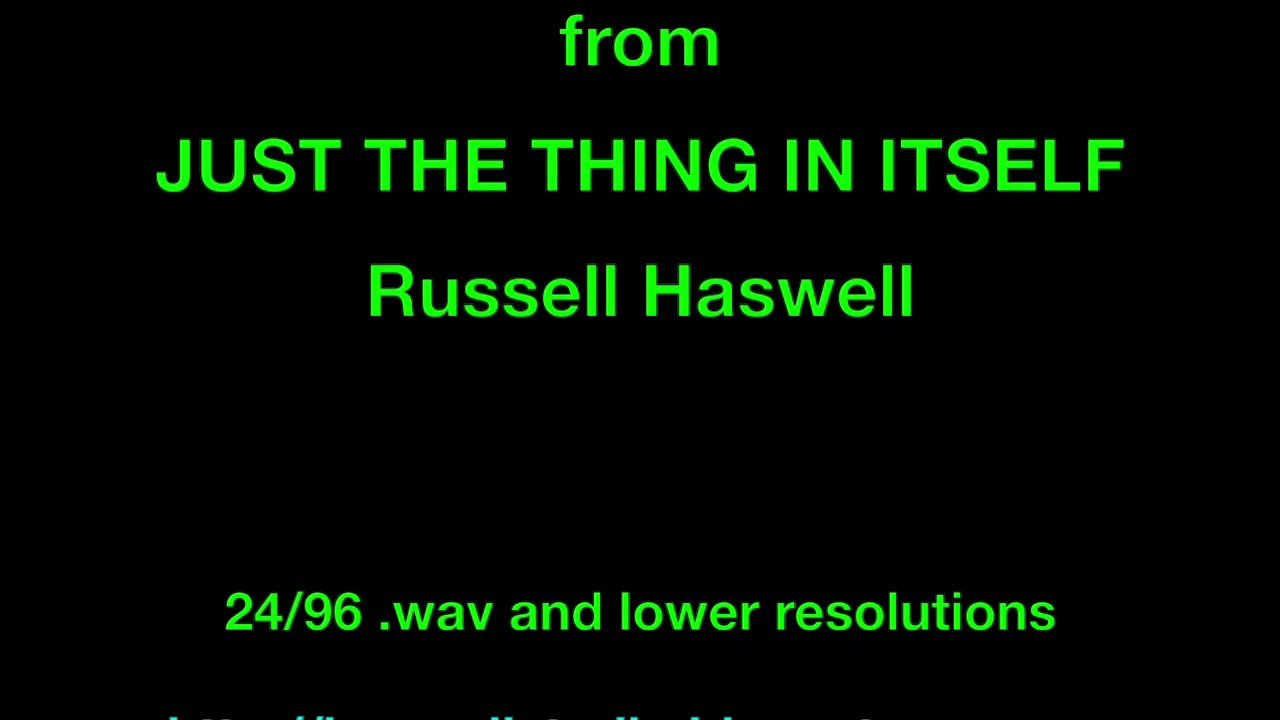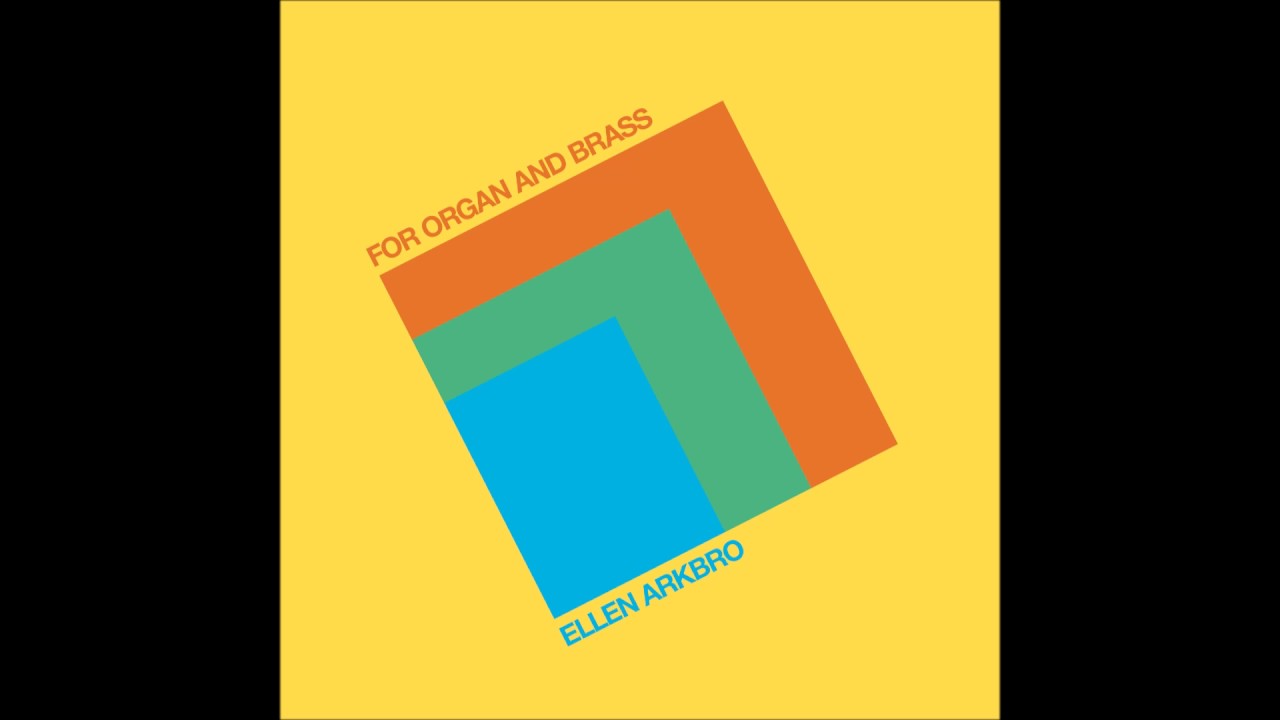Although no one here recalls booking them, everyone remembers the time when the Harkitects visited the Rum Music Library. In the week leading up to their arrival, their event was advertised on every noticeboard available. Their laminated, A4 poster bearing the title "Lending an Ear on Borrowed Time" in comic sans, each letter a different colour, was unlike the oblique, monochrome, faux-Xerox flyers more typically littering our hallways. The contrast drew the attention of staff and visitors alike, with anticipatory discussions speculating on whether it was for a charity, performance art, something for children, or a box-ticking exercise to position the Library as a provider of community services or training for staff.
Despite rife scepticism common within these walls the Library’s lecture room was packed to capacity on the day of the event. The audience’s hubbub politely decayed as one of the trio of professionally-dressed speakers switched on their laptop to project its screen large, albeit at the wrong aspect ratio, on the back wall. Each then took it in turn to earnestly deliver their audio-visual Powerpoint presentation, consistently beginning each sentence with the word "So…", preceded by an inward breath and a soft hand-clap.
The bullet points that progressively slid into view were interesting enough, all seeming to do with ways of listening. I noted three of François Delalande’s modes of perception – something about how a listener may detect structure (taxonomic), conduct sensations (empathic), or go on an adventure-like experience (figurativisation). But any deeper understanding was frustratingly thwarted by the severely hushed tones the speakers adopted – a kind of shy, deferent mumbling that no one was brave enough to point out lest they upset the seemingly fragile delegates. Consequently, the audience rocked between a frowned, desperate craning as we stretched uncomfortably forward to grasp what we could of their soft speech, and a defensive retreat when loud electroacoustic illustrations were blasted over their imposing PA designed for much larger rooms.
In the days that followed the Harkitects presentation gathered much mirth from colleagues drolly remarking on the irony of not being able to hear their words of wisdom. But, slowly, as the days turned to weeks, people were proclaiming to have had their hearing renewed. Since then, the Library’s acquisitions have taken on a new light, as if the presentation had syringed our ears. Theories now abound of how their awkward, imbalanced delivery was deliberate, as if to prove that how you listen now affects what you listen to next, and that by exercising all modes of listening you will yield the most profound results.
Russell Haswell – Just The Thing In Itself
(Haswell Studio)
The title of this new, self-released album from Russell Haswell wisely echoes Cage’s suggestion to “let sounds be themselves” and Schaeffer’s concept of “reduced listening”. But perhaps it also alludes to the instinctive satisfaction referred to by Orwell in 1984 as lovers Winston and Julia simplified their enjoyment of sex to “the thing in itself” before complex emotions made consequences of their relationship more difficult to endure.
Recorded just a few weeks after his previous album, PANTHER nO!se, Haswell continues to masterfully manipulate his sounds to travel seamlessly from scorched terrain to boiling liquid. Once again proudly proclaiming “no edit / no midi” was involved, this high-speed hurtle through states of noise almost continually spits a virtual g-force from the speakers as one second the air is exploding around us and the next we’re being buried under a landslide.
However, this is no murky, multi-layered ‘noise-fest’. Haswell’s unique sounds have a purity about them – they rip clean through the air in high definition to become a sheer, physical force resulting from an artistic practice that feels more like sculpture than composition.
Those for whom listening to music is a relaxing pastime, this album could be a violating experience. Measured in musical terms, this is the equivalent of a series of extended solos perhaps akin to Hendrix at Woodstock, but improvising with synth modules instead of six strings. But taken as a series of experiences, like white water rafting or walking on hot coals, say, and the uninitiated listener is in for a red-letter day treat. Triangulating the excitement found in grindcore, the physicality of techno and the abandon of Japanese noise, Just The Thing In Itself is yet another literally sensation-giving workout from Haswell and, as such, is truly life-affirming.
Loke Rahbek – City Of Women
(Editions Mego)
Loke Rahbek has released hundreds of recordings ranging from his confrontational electronics as Damian Dubrovnik (with Christian Stadsgaard) to an introspective synth-pop as Croatian Amor, not to mention the vast catalogue his Posh Isolation label has built since its inception in 2009, which included two of last year’s standout servings: the powerful electronics of Puce Mary’s The Spiral and the cinematic analog themes of Body Sculptures (in which Rahbek performed). All this industrious activity has put his hometown of Copenhagen on the industrial map, and yet this latest solo release is the first to bear his full name, as if to suggest the turning of a new leaf.
The sounds on City Of Women, while consistently defying their track titles (such as how the opener ‘Like A Still Pool’ is like a deep restless ocean of synth chords), perhaps ride the full range of Rahbek’s audio interests as they effortlessly flit from tension and fear to a more relaxed contemplation. The title track, far from suggesting Fellini’s fantasy comedy with which it shares its name, is a seriously grand choreography of chords that interweave majestically at varying tempos, haunted all the while by an introspective melody. Later, the same neon-lit synth matter morphs from harmonium-like suspensions to the density of church organs on ‘In Piles of Magazines’, where they bristle, writhe and multiply at an alarming rate until cacophonous.
Both tender and terrifying, City of Women’s elusive yet dramatic narrative is an artfully detailed performance: the editing of each chords’ attack and decay often creating subtly nuanced rhythms along with a disorienting sense of losing balance, while delicately buried melodies add depth to Rahbek’s extraordinarily textured modulations.
Ellen Arkbro – For Organ And Brass
(Subtext Recordings)
‘For Organ And Brass’, the 20-minute title piece from Ellen Arkbro’s debut album, is like a carefully choreographed sunrise – it emerges gracefully and purposefully, steadily increasing its radiance while casting subtly shaped moving shadows.
Ignoring the giveaway in its title, it sounds like a series of long see-sawing chords played on one giant, mysterious instrument, rich in harmonics. The closest I have heard to these seemingly simple but quite probably complex sonic manoeuvres is on the recent releases of Catherine Christer Hennix so it is no surprise to learn that the brass performers here – Elena Kakaliagou on horn, Hilary Jeffery on tuba and Robin Hayward on trombone – are also in Hennix’ band: the sublime Chora(s)san Time-Court Mirage.
Arkbro composed the piece following studies with pure tone pioneers La Monte Young and Marian Zazeela whom Hennix worked closely with towards the end of the sixties. At its foundation is Young’s tuning strategies – mathematically-considered frequency ratios that delicately transform both harmony and texture. These are followed with a seemingly impossible exactitude by the brass trio accompanying a specifically sourced 17th century organ played by Johan Graden.
It comes with a second piece, ‘Three’, that has the brass trio play by themselves a similar sequence to its predecessor. ‘Three’ acts as a kind of come down from the emotionally absorbing nature of the title track, like a soothing reprise, or the memory of a sunset tenderly lingering on into the night.
Sophie Cooper & Julian Bradley – The Blow Volume 3
(Front & Follow)
Following their performance at last year’s Supernormal festival, Julian Bradley, founder member of Vibracathedral Orchestra, and experimental songsmith Sophie Cooper team up once again on the third volume of The Blow, Front & Follow’s curious split cassette series.
We are told Cooper and Bradley’s collaboration was done "with the cassette format very much in mind, collaborating fully on each track throughout the album by means of file sharing." And upon pressing play one might occasionally wonder whether the oxide on both sides of the tape are playing at once as their exuberant, dreamy delirium travels in all directions.
It is a great example of the freedom a distance collaboration might afford, where social pressures of live improvisation or jamming don’t exist, and, like an exquisite corpse illustration, a form evolves undaunted by what has gone before or after.
That said, there’s an array of consistent elements that cohesively contain the chaos. Cooper’s folk song sinks in and out of DIY electronics on tracks like ‘Wish Me To Forget You’ and ‘Nowhere From The Water To Go’ where a rippling guitar is invaded by a deep trombone and what sounds like a droning shruti box. Elsewhere generous measures of delay and fuzzbox respectively spread and degrade tones from guitar, electronics and keys with scrubbed tape added for good measure.
Its groovy surreality lends it a cult science fiction angle and, somehow Sapphire & Steel came to mind casting Cooper and Bradley as the agents exploring the temporal dimension. With a palpable wooziness pitched somewhere between love and madness they serve up a satisfying avant-psyche adventure.
Drøne – A Perfect Blind
(Pomperipossa Records)
Last year’s distinctive debut from Drøne was likened to a hurtling journey. It’s combination of field recordings, shortwave radio and modular synths possessed an excited, driving energy whose route was hitherto unexplored and destination unknowable. But with an expanded sound pool boasting instruments across the ages – from guitar, through pipe organ and strings to dulcimer and psaltery – its follow-up takes a sideways step into more cognizant, reflective pastures. Its accompanying notes seem to confirm this position, indicating how ‘a perfect blind’ means "the best possible observation point where the viewer is unseen by the object of interest" but then goes on to ask, "is this the best place to be?"
Both of A Perfect Blind’s long form pieces have brief samples of telephonic voice that emerge out of Drøne’s delicate and refined weave of suspended electronics and stealthy strings. They suggest a meditation on distant webs of communication, like a watchful alien intelligence who for centuries has remained curious but too circumspect and wary to make contact. However, as they steadily and gracefully travel to their conclusions, both pieces develop into more musical passages, perhaps to inject a sense of pathos, as if memories of beauty are identified in wake of the more foreboding environments of the present.
Francisco López – Untitled (2012-2014)
(Purple Soil)
Francisco López – Untitled #352
(Nowhere Worldwide)
Francisco López consistently audacious journeys into the hidden worlds of sound are hard to keep up with. The past twelve months has not only seen him showcase his uniquely processed field recordings in the form of several startling albums and concerts, but he also conceived and directed the epic audio-DH, a collection of 195 tracks by 250 artists based in The Hague and then fed the results into a system he co-developed to autonomously create ‘meta-compositions’. It would seem he is on a mission to serve up deep listening material in quantities impossible to devour. But, unlike those of us struggling to cover such sterling work, he sees the ubiquity of soundworks as a "blessing" leading to the obsolescence of "comprehensibility and regulation" and leading to "an expansion of the very concept of ‘audio-artist’".
Untitled (2012-2014), is a good place to start should you wish to dip your toe into his ocean of sound. It brings together sixteen pieces from various underground compilations to give a broad survey of López’ idiosyncratic approach. Ranging from two-and-a-half to fourteen minutes in duration, each piece is like a portal into a new, but related dimension. With deliberately little by way of context, the consistently untitled pieces of processed sound matter may initially suggest a field of insects (‘untitled #317’), the elements (‘untitled #311’) or an air conditioner (‘untitled #304’), but once the brain has dropped its urge to comprehend you become immersed in vortices of vibrations whose hidden qualities emerge continuously, almost like the ego death of a psychedelic experience.
But for the experienced or foolhardy traveller, López’ latest release, Untitled #352, is perhaps his heaviest trip yet. It is a memory stick containing ten ‘MANTRAcks’, each precisely half-an-hour in duration. The rare title hints at a repetition, which leads me to suspect each track draws on the exact same field recording of the vaporous clamour of an urban boiler plant facility near Paris. However, each has been transformed by López in such a way as to feel like a series of separate immersive environments. Following five hours of travelling through ten pressurised, parallel worlds, we arrive at the 20-minute end piece, originally for a choreography by Anne Collod, that jump cuts between contrasting textures (presumably from the same location).
In comparison to the compilation of shorter tracks this release shows that the longer you can spend in López’ remarkable soundworlds the more magic you will find.
Hans-Joachim Roedelius & Carl Michael von Hausswolff – Nordlicht
(Curious Music)

Last year, the twelfth and final outing of CM von Hausswolff’s Freq-Out installations took place in the Viennese sewer famous for its appearance in Orson Welles’ The Third Man. Hausswolff had invited Roedelius along with eleven other sound artists of note, who were each given different, specific frequency ranges in which to perform to collectively build a “generative sound-space”.
Hausswolff had been following Roedelius’ music since the seventies when the initial electronic experiments Roedelius made as part of Kluster went on to clearly inform the original Industrial sound that emerged at the end of that decade. Apparently, around the time of the installation, he taught Roedelius how to play music from scores (something the octogenarian had yet to do) and, from here, the two set about a series of “informal creative exercises” involving piano, sinewave generators, synths and EVP recordings (the capturing of spirit voices on tape, a passion of Hausswolff’s). The highlights from these sessions are now presented here as Nordlicht.
There’s three short pieces on the second side – ‘These are The Keys’ bears psychoacoustics that mess with your mind as any head movements affect playback; ‘At The Island’ places you on the shoreline of Lanzarote, the field recording mysteriously phasing under a mysterious, sonorous theme; while, ‘Find The Way’ is a slow swim through warm, circling organ chords.
But it is the striking lead piece, ‘Let Her Go’, which stretches across the whole of the first side, that was perhaps inspired by the pair’s first meeting in the Viennese sewers. Its low, string-like tones sink slowly, giving rise to a striking sensation of flowing down a hollowed-out, subterranean space. A vocal sample – presumably an EVP recording – rough and encrusted as if fossilised, repeats, chillingly demanding we “let her go”. Meanwhile drowning piano notes stir the harmonic pool, whose combined powers are now operating on a hypnotic level, where it is, perhaps, our consciousness that the ghostly voice has been encouraging us to let go of all along.
Zbigniew Karkowski – The Last Man In Europe
(Erratum)
This live recording of Polish electronic artist Zbigniew Karkowski’s last public performance was captured before his untimely passing six weeks later in Peru where he sought shamanic healing from cancer. The two-hour set took place six weeks earlier in the esoteric environs of London’s Horse Hospital, where it accompanied a rare screening of a BBC production of Orwell’s 1984 from 1954 – back when actors were required to perform live on the night of the broadcast and when the story would still feel firmly set in the future.
Divorced from the visual component means the sounds can be absorbed on their own merit. In fact, it is difficult to imagine how anyone could have spared the attention to anything resembling a narrative with such a forceful, molten morphology of electronic frequencies filling the space.
Indeed, from the opening rush of static and sine waves rising and falling over long wave satellite debris, through the arch artefacts bouncing and colliding, to the shredded turbulence of the finale, it feels less like a soundtrack and more a psychological experiment. The sheer power of Karkowski’s constant flux imposes a fantastical sense of scale on the listener, as if shrunken like in the film Fantastic Voyage, but, instead of journeying through a human body, our microscopic craft is travelling on an electrical current, from generator, to cable, to transmitter. The experience is daunting, intimidating and gripping.
While it is tragic that Last Man In Europe marks the premature termination of Karkowski’s mission into unchartered realms of sound, the exhilarating vivacity transmitted throughout strongly encourages return visits to his many releases comprising over three decades of uncompromising audio interrogations.
Tracklist for the Rum Music Spring 2017 mix
00:00-00:20 Intro (includes an excerpt from ‘Music of the Spheres’ – Johanna Beyer / 1938)
00:16-03:54 sept 20th – Russell Haswell (from Just The Thing In Itself / Haswell Studio 2017)
03:52-10:14 City Of Women – Loke Rahbek (from City Of Women / Editions Mego 2017)
10:01-15:30 three (excerpt) – Ellen Arkbro (from for organ and brass / Subtext Recordings 2017)
15:28-19:06 Nowhere From The Water To Go (excerpt) – Sophie Cooper & Julian Bradley (from The Blow Volume 3 / Front & Follow 2017)
18:33-27:20 cutting the screen (excerpt) – drøne (excerpt) (from a perfect blind / Pomperipossa Records 2017)
27:01-33:01 Untitled #314 – Francisco López (from Untitled (2012-2014) / Purple Soil 2017)
31:15-37:45 Let Her Go (excerpt) – Hans-Joachim Roedelius & Carl Michael von Hausswolff (from Nordlicht / Curious Music 2017)
37:07-44:05 The Last Man In Europe, part 1 (excerpt) – Zbigniew Karkowski (from The Last Man In Europe / Erratum 2017)
44:02-44:21 Outro (includes an excerpt from ‘Music of the Spheres’ – Johanna Beyer / 1938)




